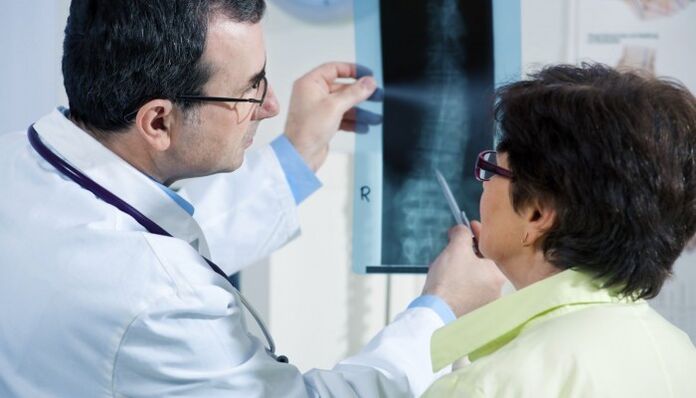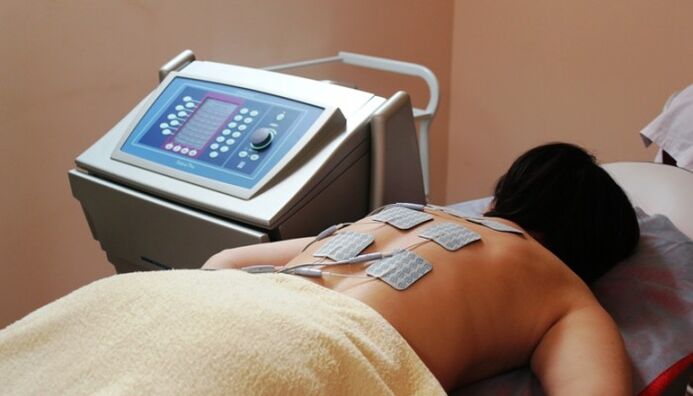Osteochondrosis is a chronic pathology of the spine, the main cause of which is degenerative changes in the intervertebral disc. With the development of the disease, other structures of the spine are also involved in pathological processes - the vertebral body, intervertebral joints, ligaments, etc.
The disease affects people of all ages. Until recently, osteochondrosis was considered by many elderly people, but recently an increase in the incidence of this disease among young people has been revealed. Both women and men often get sick.
Why does osteochondrosis occur?
To better understand what is osteochondrosis, it is necessary to think briefly about the causes and mechanisms of its occurrence.
The formation of pathological changes in spinal osteochondrosis occurs slowly. Years often pass from the beginning of pathological processes in the intervertebral cartilage to the manifestation of the first symptoms of osteochondrosis.
Causes of osteochondrosis
Spinal health is directly influenced by many negative factors. If their influence is carried out for a long time, then the result is the appearance of pathological changes in the structure of the spine. And this contributes to the formation of osteochondrosis.
For example, what is osteochondrosis is known by people who lead an inactive lifestyle, who are overweight. Excessive physical activity, back and neck injuries, some somatic diseases can also lead to the development of this pathology. And severe heredity and old age are direct factors leading to the development of degenerative damage to disc cartilage tissue.
How does osteochondrosis develop?
The mechanism of development (or pathogenesis) of osteochondrosis is still controversial and not adequately studied. Most likely the disease is formed based on metabolic disorders that occur in the structure of the spine.
Under the influence of adverse factors, often irreversible changes in the cartilage tissue of the intervertebral disc occur, followed by gradual destruction (or annihilation).
The pathological process then also spreads to the vertebral bone tissue with the development of deformities and irreversible changes in the surrounding structure.
The appearance of such modifications in the intervertebral disc directly depends on its anatomical nuances:
- Cartilage tissue does not have its own blood supply system. Its nutrition is provided by neighboring vertebral bone tissue. Thus, in the case of circulatory disorders due to insufficient or, conversely, excessive physical stress on the spine, cartilage nutrition also suffers.
- Also no nerve fibers in the cartilage. As a result, with the advantage of intervertebral disc function, the transmission of nerve impulses that trigger metabolic activation will be untimely.
- The ability for self-healing (regeneration) of intervertebral disc cartilaginous tissue is slowed due to its structural features.
There are also other factors that clearly contribute to the development of degenerative processes in the cartilage tissue of the intervertebral disc and the formation of osteochondrosis.
The degree of pathological change
Based on current data on the pathogenesis of this pathology, several stages of degenerative processes in the intervertebral disc can be conditionally distinguished. Stages of spinal osteochondrosis:
- low level. Disc cartilaginous tissue undergoes structural changes under the influence of mechanical - its dysfunction occurs. Characterized by the appearance of cracks on the surface of the disc, varying in size and depth. After that, this fracture turns into a protrusion (hernia).
- The middle. It is characterized by the appearance of instability of the affected area on the spinal column due to pathological movement of the vertebrae. In this case, one of the main functions of the spine, the protective, is disrupted. The nerves and vascular trunks that run in his bone ducts become exposed. The clinical symptoms of the disease clearly develop.
- finite. There is replacement of the affected cartilage tissue with coarser and denser fibers. At the same time, the intervertebral hernia disappeared. And the pathological mobility of the vertebrae is replaced by a sharp restriction of their movement. Often there is a narrowing of the spinal canal with the development of manifestations of compression of the spinal cord segments.
Thus, each stage of the disease is characterized by the presence of its own particular symptoms, which undoubtedly play an important role in the choice of methods for treating osteochondrosis.
Clinical manifestation
Signs of spinal osteochondrosis appear as changes in the vertebral bone tissue. The patient may not submit any complaints for quite some time.
The disease is characterized by a chronic course, with phases of exacerbation and remission replacing each other.
Often, the exacerbation of osteochondrosis occurs under the influence of provoking factors: physical overstrain, hypothermia, prolonged exposure to uncomfortable positions, for example, in dreams or at work, etc.
There are many symptoms of the disease, which depend on the localization of pathological processes and the severity of structural changes in cartilage and bone tissue. All these symptoms can be grouped into several syndromes. Often they are combined.
radicular syndrome
It occurs in almost all patients with spinal osteochondrosis. In the occurrence of this syndrome, compression (compression) of the spinal nerve roots by pathologically altered spinal structures plays a role.
The main sign of radicular syndrome is pain, which in a large number of cases is capable of spreading (irradiation) along the corresponding root conservation course. Characterized by radiating pain from top to bottom. For example, if the lumbar region is affected, the back hurts and gives to the legs.
The intensity of pain increases with rotation of the trunk or neck, physical activity. The sensation of pain is characterized as cutting, pulling, burning.
Also, along with the pain syndrome, in the affected area, symptoms of violation of sensitivity by its type of increase (hyperesthesia) often develop, as well as disorders of sensitivity, numbness.
If the disease persists and the cause of the compression is not eliminated, then hyperesthesia is replaced by hypoesthesia (decreased sensitivity), which is often accompanied by symptoms of loss of function of the affected spinal roots.
spinal syndrome
This syndrome develops as a result of compression of the spinal cord. The most common cause of compression is an intervertebral hernia.
There is a decrease in sensitivity, a response to temperature and an increasing pain stimulus. Progressive muscle weakness develops in both the limbs and trunk. Symptoms of paralysis or paralysis often form.
Vegetative-vascular syndrome

This syndrome most often develops in the localization of cervical and cervicothoracic spinal osteochondrosis.
The cause of vascular disorders in osteochondrosis is reflex spasm or mechanical compression of large vessels that pass through the spinal canal. In this case, a variety of symptoms may develop, resembling ischemic circulatory disorders of the brain or major arteries of the legs. This is often the cause of diagnostic errors.
In addition, various vegetative disorders often develop. They are most noticeable in women (emotional lability, sleep disturbances, menstrual irregularities, etc. ).
visceral syndrome
It is characterized by the occurrence of pain in the projections of the heart, organs of the gastrointestinal tract, and others. Often such patients are treated for a long time and are completely unsuccessful for any somatic diseases.
For example, if the thoracic area is affected, pain in the back of the sternum may occur, resembling those with angina pectoris. Often there is a reflex sensation of the heartbeat.
Diagnostic principles
In addition to characteristic symptoms, additional screening methods play an important role in determining the disease and staging - X -rays of the spine, computed and magnetic nuclear tomography.
According to the indications, other methods are performed, for example, EEG, ECG, Doppler scanning of blood vessels, etc.
Treatment of osteochondrosis

Spinal osteochondrosis therapy is an integrated approach. When choosing one or another method of treatment, it is necessary to assess the degree of damage to the structure of the spine, the nature and severity of clinical manifestations, as well as the stage of the disease course (exacerbation or remission). .
An important role in the treatment of spinal osteochondrosis is also played by preventive measures aimed at reducing the frequency of disease progression and preserving the structure of the vertebrae and intervertebral discs.
Tactics during exacerbations
An important condition for the treatment of disease during this period is the creation of other areas of the affected spine. To do this, the patient is prescribed a sleep break using a variety of devices to create immobility on the affected vertebral segment.
In some cases, hospitalization in the neurology department is required.
Medical treatment
To reduce the intensity of pain in osteochondrosis, various medications are prescribed:
- nonsteroidal anti-inflammatory drugs (NSAIDs);
- analgesic;
- muscle relaxants.
If there is no effect of its use, it is advisable to prescribe restrictions on the conservation of the affected area with the use of local anesthetics.
With the localization of cervical osteochondrosis, cerebral circulatory disorders often develop. To reduce such manifestations, medications are prescribed that increase cerebral blood flow. It is also necessary to use symptomatic medications - relief of nausea and vomiting, increased vestibular disorders, etc.
In addition, it is advisable to prescribe preparations of vitamins (especially group B), antioxidants and some others.
Physiotherapy procedures

With osteochondrosis, treatment with physical factors has found wide application. Various methods of physiotherapy are used during exacerbations and in the remission phase of the disease:
- In the acute period, ultraviolet irradiation, treatment with electromagnetic fields (UHF), diadynamic currents, etc.
- In the remission phase, electrophoresis with various drugs, inductothermia, ultrasound and various types of balneotherapy are prescribed.
Tactics in the remission phase
After the acute manifestations of the disease subsided, treatment of the disease was continued. The purpose of such therapy is to reduce the frequency of exacerbations and promote the regrowth of bone and cartilage tissue of the spine.
Drug treatment prescribed for the acute phase of the disease is ongoing. During this period, chondroprotectors can be used - agents that improve the condition of cartilage.
In addition to physiotherapy methods, massage and physiotherapy exercises are also used.
massage

The main effect of the massage is aimed at improving blood circulation in the affected area and strengthening the muscular corset. Also, the professional performance of massage movements allows you to relieve muscle spasms, which usually accompany this pathology.
That is why the massage should be performed by a specially trained specialist who is fluent in this method of treatment. Improperly performed or illiterate sequences can lead to the development of complications or exacerbation of the disease.
Therapeutic exercise (LFK)
Dosed and specially selected physical exercises form the basis of exercise therapy. Such training complexes are selected by the physician individually for each patient. The principle of selection of exercise therapy exercises is to reduce the physical load on the affected spinal area.
The action of physiotherapy exercises aims to increase blood supply and lymph flow to the affected area, strengthening muscle tissue.
This exercise needs to be done every day. Usually, initially, individual or group classes are held with an instructor, then the patient can do a set of exercises independently at home.
Prevention of exacerbation
Measures to prevent exacerbation of spinal osteochondrosis aim to eliminate all the provoking factors:
- It is necessary to monitor the correct posture and posture while standing and sitting for a long time.
- It is useful for prolonged static stress (for example, working in front of a computer) to rest regularly where you need to do a warm -up or a set of exercises recommended by your doctor.
- Hypothermia should be avoided.
- It is important to sleep properly with osteochondrosis, take care of bedding - mattresses and pillows. Ideally, they should be orthopedic.
- Mandatory is the reduction of excess weight and timely correction of corresponding somatic and endocrine pathologies.
And when the slightest symptoms of spinal disease appear, you should not delay a visit to the doctor. After all, the earlier treatment of spinal osteochondrosis is started, the better the result.













































